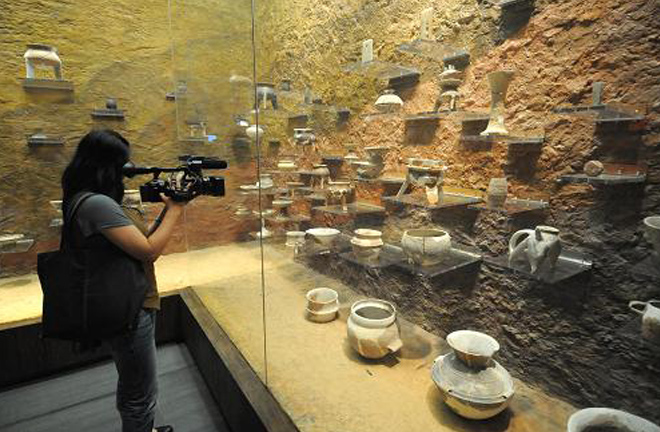Comparative research traces origin of Chinese civilization

A visitor takes videos of the pottery exhibits at the Liangzhu Culture Museum in Hangzhou, Zhejiang Province. The Liangzhu site is one of the largest and most valuable pieces of evidence that prove Chinese civilization dates back to about 5,000 years ago.
This year marks the final stage of a project titled “In Search of the Origins of Chinese Civilization.” By examining dialogues among early civilizations and conducting comparative studies, participating scholars say they aim to gain insight into the nature of ancient Chinese culture and its role in human civilization.
On April 6, an international conference titled “Dialogue of Civilizations: Comparing Multiple Centers of Early Civilizations of the World” was held in Beijing. Top archaeologists from China and abroad discussed five main topics, including the achievements of Chinese archaeology in its investigations of early civilizations conducted from 1985 to 2015, origins and forms of early states, origins and roles of writing, landscapes, agriculture, craft production and trade, as well as comparative studies on early civilizations from a global perspective.
Scholars said the conference presents a good platform for the East-West cultural communication so that the exchange and integration of ancient civilizations can be better understood, which in turn offers a new direction for future archeology studies.
The origin, formation and development of civilization have long been the primary areas of inquiry for the study of human history. Wang Wei, director of the Institute of Archaeology at the Chinese Academy of Social Sciences, said that Chinese civilization is one of the four great ancient civilizations of the world, and it is the only ancient civilization that has survived to the modern era.
However, some foreign scholars have been skeptical of this assertion. The best way to overcome this criticism is to get new evidence through archaeological excavation, Wang said.
Li Boqian, a professor of archaeology at Peking University, introduced several points of consensus that have been reached after 80 years of archaeological work in China. First, the development of Chinese civilization has gone through three stages, namely Guguo (chiefdom), Fangguo (archaic states) and Diguo (fully formed empires).
Second, the evolution of Chinese civilization has been a process that combines cultural diversification and unification. Finally, the development of Chinese civilization has not followed a linear model. Sites in different regions grew and shrank, combined and separated, and when woven together, these different trajectories tell the full story of China’s beginnings.
The biggest achievement of the project “In Search of the Origins of Chinese Civilization” is that it studies the development of Chinese civilization in terms of its progression from diversity to unity, said Zhao Hui, president of the School of Archaeology and Museology at Peking University.
Liangzhu culture was an important stage in the process of melting different cultural milieus into one Chinese civilization, Zhao said. Given the large size of the country and the complexity of geographical regions, the origins and development of early Chinese civilization should be looked at categorically on the basis of different cultural zones and their relationships with one another.
Liangzhu culture was thought to be a late Neolithic culture, said Liu Bin, director of the Zhejiang Provincial Institute of Archaeology and Cultural Relics. However, the findings of buried handicrafts, settlement patterns, large noble tombs and grand sacrificial sites indicate that primary civilization and early states had already taken shape at that time, Liu noted.
“The hierarchical differentiation uncovered in Liangzhu culture shows that it was roughly in the same era as the ancient Egyptian civilization,” he said.
The Liangzhu walled city was also the largest city of the same period ever discovered in China. Finding the center of Liangzhu culture has helped to establish the structure of the entire civilization, offering a methodology that can be mimicked in future excavation, Liu continued.
Using current evidence, Dorian Fuller, a professor from the Institute of Archaeology, University College London, made a comparison between the Yellow River, Indus River, Mesopotamia and Nile River in terms of their agricultural basis and summarized three questions for future studies on different cultures to consider: What is civilization? Who creates it? And what sustains it?
